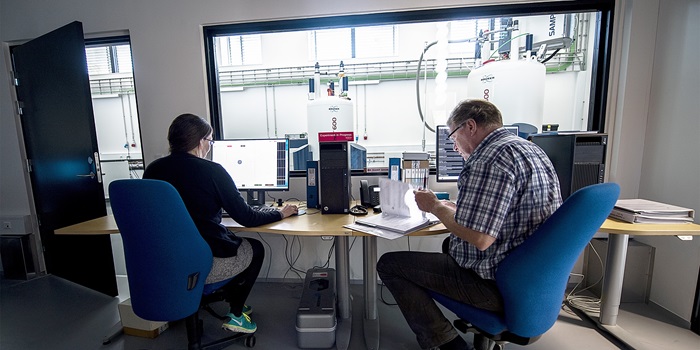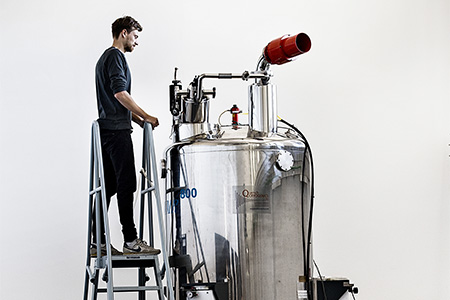The official opening of Building 212, which now houses DTU’s new centre for
Nuclear Magnetic Resonance (NMR), will be held on 13 December.
It is just over two years since VILLUM FONDEN made available a grant of DKK 16 million for a new generation of NMR spectrometers at DTU Chemistry. The two new instruments, together with the existing unit that was previously donated by Carlsberg, have now been housed in a separate facility, and 13 December will see the official opening of Building 212: NMR Center—DTU.
From the outside, the building is not overly impressive, standing wedged in between Buildings 207 and 208. However, signs on the beech hedge all around the property warn that there is a strong magnetic field here, and entry is prohibited for people with pacemakers. Moreover, if you want to access the instruments themselves, you have to remove all jewellery, watches, screwdrivers and other magnetic items. Cameras are not permitted either, so the pictures on this page were taken from the doorway.
NMR instruments are fitted with a powerful magnetic field, where molecular samples are placed and subjected to the influence of radio wave pulses. This generates a range of signals that can then be interpreted to provide understanding of which atoms make up the substance in question, and how they are positioned in relation to one another.

Understanding a given structure is quite a puzzle, however, and there are no ‘answer sheets’ to show the way. DTU Chemistry has spent years building up strong competences in this area. There are NMR spectrometers in other DTU departments, but the new centre will enable the University to consolidate NMR research in a central strategic infrastructure. The centre is both to communicate the opportunities in the technology, and work with all NRM users at the University.
“Our current focus is on small to medium-sized molecules, and we have the facilities to analyse proteins. The spectrometers can also be used to analyse solid substances, but this requires a new probe. There is plenty of interest in analyses of this kind, so we hope to find the funds to make new investments. The building also gives us the chance to expand our instrument fleet,” says Associate Professor Charlotte H. Gotfredsen, one of the driving forces behind the process to establish the new NMR centre.
 |
|
Building 212 currently houses a total of three NMR-spectrometers. Two of them operate with a magnetic field of 18.8 T (800 MHz), while the third operates at a field of 14.1 T (600 MHz).
The magnets are the heavy component in the NMR-instruments, with the heaviest weighing around 4,000 kg.
The ‘small’ magnet weighs almost 1,000 kg. On account of the heavy weight they have to support, the foundations consist of a 40-cm-thick concrete deck resting on 16 concrete columns, each measuring 7 metres in length.
See the website: nmrcenter.kemi.dtu.dk
|